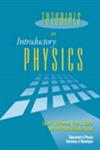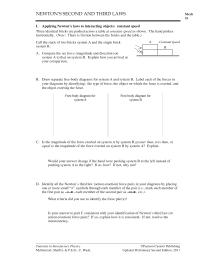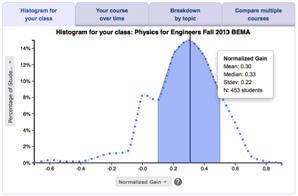
Developed by: Lillian C. McDermott, Peter S. Shaffer and the Physics Education Group at UW


middle schoolhigh schoolintro collegeinter-mediateupper levelgrad school other

calc based

alg based










Overview
What? Guided-inquiry worksheets for small groups in recitation section of intro calculus-based physics. Instructors engage groups in Socratic dialogue. Worksheets use Elicit-Confront-Resolve model: Questions elicit known student difficulties and help students confront and resolve these difficulties.
Why? Each tutorial carefully guides students to overcome specific difficulties. Developed through rigorous research and redesign to ensure student learning. Can be plugged into a recitation section and led by teaching assistants and improve student learning without altering the rest of your course.
Why not? Designed for calculus-based physics courses, and may not work as well with other populations. Tutorials confront students' naive intuitions, which may give them a sense that their intuition is always wrong, reducing their confidence and enjoyment of physics. Students have to buy an extra book.
Classroom video
Topic outline
| Part I: Mechanics Kinematics Velocity Representations of motion Acceleration in one dimension Motion in two dimensions Relative motion Newton’s laws Forces Newton’s second and third laws Tension Energy and momentum Work and changes in kinetic energy Conservation of energy Conservation of momentum in one dimension Changes in energy and momentum Rotation Rotational motion Dynamics of rigid bodies Equilibrium of rigid bodies Conservation of angular momentum Simple harmonic motion
Electrostatics |
Part III: Waves Superposition and reflection of pulses Reflection and transmission Propagation and refraction of periodic waves Electromagnetic waves Part IV: Geometrical optics Light and shadow Plane mirrors Curved mirrors and multiple reflections Interpretation of ray diagrams Convex lenses Magnification Part V: Physical optics Two-source interference Wave properties of light Multiple-slit interference A model for single-slit diffraction Combined interference and diffraction Thin-film interference Polarization Part VI: Selected topics Hydrostatics Pressure in a liquid Buoyancy Thermodynamics The ideal gas law A microscopic model for an ideal gas The first law of thermodynamics Heat engines and the second law of thermodynamics Modern physics: Waves and particles Wave properties of matter The photoelectric effect Wave-particle duality Modern physics: Special relativity Events and reference frames Measurement in special relativity Simultaneity Electric and magnetic fields in multiple frames of reference |
Student skills developed
- Conceptual understanding
- Using multiple representations
- Problem-solving skills
- Making real-world connections
- Metacognition
Instructor effort required
- Medium
Resources required
- TAs / LAs
- Simple lab equipment
- Cost for students
- Tables for group work
Resources
You can learn more about facilitating tutorials from our series of videos on the implementation of Tutorials in Introductory Physics in the University of Colorado.
The University of Washington Physics Education Group regularly welcomes visitors interested in learning more about implementing tutorials. Contact them to arrange a visit.
Teaching Materials
Tutorials in Introductory Physics come in a book published by Pearson. You can order them from Pearson or from Amazon. You can download a sample tutorial from PhysPort.
You can find instructor guides and other resources for supporting the implementation of Tutorials in Introductory Physics on the UW Tutorials curriculum page.
Research
This is the highest level of research validation, corresponding to:
- both of the "based on" categories
- at least 4 of the "demonstrated to improve" categories
- at least 5 of the "studied using" categories
Research Validation Summary
Based on Research Into:
- theories of how students learn
- student ideas about specific topics
Demonstrated to Improve:
- conceptual understanding
- problem-solving skills
- lab skills
- beliefs and attitudes
- attendance
- retention of students
- success of underrepresented groups
- performance in subsequent classes
Studied using:
- cycle of research and redevelopment
- student interviews
- classroom observations
- analysis of written work
- research at multiple institutions
- research by multiple groups
- peer-reviewed publication
References
- B. Ambrose, P. Heron, S. Vokos, and L. McDermott, Student understanding of light as an electromagnetic wave: Relating the formalism to physical phenomena, Am. J. Phys. 67 (10), 891 (1999).
- B. Ambrose, R. Steinberg, P. Shaffer, and L. McDermott, An investigation of student understanding of single-slit diffraction and double-slit interference, Am. J. Phys. 67 (2), 146 (1999).
- S. Chang and P. Shaffer, Curriculum development to improve student understanding of rolling motion, presented at the Physics Education Research Conference 2018, Washington, DC, 2018.
- H. Close and P. Heron, Research as a guide for improving student learning: An example from momentum conservation, Am. J. Phys. 78 (9), 961 (2010).
- H. Close and P. Heron, Student understanding of the angular momentum of classical particles, Am. J. Phys. 79 (10), 1068 (2011).
- M. Cochran and P. Heron, Development and assessment of research-based tutorials on heat engines and the second law of thermodynamics, Am. J. Phys. 74 (8), 734 (2006).
- R. Endorf, K. Koenig, and G. Braun, A Preliminary Study of the Effectiveness of Different Recitation Teaching Methods, presented at the Physics Education Research Conference 2005, Salt Lake City, Utah, 2005.
- F. Goldberg and L. McDermott, Student Difficulties in Understanding Image Formation by a Plane Mirror, Phys. Teach. 24 (8), 472 (1986).
- F. Goldberg and L. McDermott, An investigation of student understanding of the real image formed by a converging lens or concave mirror, Am. J. Phys. 55 (2), 108 (1987).
- R. Hazelton, P. Shaffer, and P. Heron, Assessing the impact of a computer simulation in conjunction with Tutorials in Introductory Physics on conceptual understanding, presented at the Physics Education Research Conference 2013, Portland, OR, 2013.
- R. Hazelton, P. Shaffer, and P. Heron, Facilitating model-building of electrostatics concepts related to conductors, presented at the Physics Education Research Conference 2015, College Park, MD, 2015.
- R. Hazelton, M. Stetzer, P. Heron, and P. Shaffer, Investigating student ability to apply basic electrostatics concepts to conductors, presented at the Physics Education Research Conference 2012, Philadelphia, PA, 2012.
- P. Heron, Identifying and Addressing Difficulties: Reflections on the empirical and theoretical basis of an influential approach to improving physics education, in Getting Started in PER, edited by C. Henderson, K. Harper, and A. Robertson, (American Association of Physics Teachers, College Park, 2018), Vol. 2.
- P. Heron, M. Loverude, P. Shaffer, and L. McDermott, Helping students develop an understanding of Archimedes' principle. II. Development of research-based instructional materials, Am. J. Phys. 71 (11), 1188 (2003).
- K. Koenig and R. Endorf, Study of TA's ability to implement the Tutorials in Introductory Physics and student conceptual understanding, presented at the Physics Education Research Conference 2003, Madison, WI, 2003.
- K. Koenig, R. Endorf, and G. Braun, Effectiveness of different tutorial recitation teaching methods and its implications for TA training, Phys. Rev. ST Phys. Educ. Res. 3 (1), 010104 (2007).
- R. Lawson and L. McDermott, Student understanding of the work-energy and impulse-momentum theorems, Am. J. Phys. 55 (9), 811 (1987).
- B. Lindsey, P. Heron, and P. Shaffer, Student ability to apply the concepts of work and energy to extended systems, Am. J. Phys. 77 (11), 999 (2009).
- L. McDermott, M. Rosenquist, and E. Van Zee, Student difficulties in connecting graphs and physics: Examples from kinematics, Am. J. Phys. 55 (6), 503 (1987).
- L. McDermott and P. Shaffer, Research as a Guide for Curriculum Development: An Example from Introductory Electricity. Part I: Investigation of Student Understanding, Am. J. Phys. 60 (11), 994 (1992).
- L. McDermott, P. Shaffer, and M. Somers, Research as a guide for teaching introductory mechanics: An illustration in the context of the Atwood's machine, Am. J. Phys. 62 (1), 46 (1994).
- T. O'Brien Pride, S. Vokos, and L. McDermott, The challenge of matching learning assessments to teaching goals: An example from the work-energy and impulse-momentum theorems, Am. J. Phys. 66 (2), 147 (1998).
- L. Ortiz, P. Heron, and P. Shaffer, Student understanding of static equilibrium: Predicting and accounting for balancing, Am. J. Phys. 73 (6), 545 (2005).
- M. Rosenquist and L. McDermott, A conceptual approach to teaching kinematics, Am. J. Phys. 55 (5), 407 (1987).
- R. Scherr, P. Shaffer, and S. Vokos, Student understanding of time in special relativity: Simultaneity and reference frames, Am. J. Phys. 69 (S1), S24 (2001).
- R. Scherr, P. Shaffer, and S. Vokos, The challenge of changing deeply held student beliefs about the relativity of simultaneity, Am. J. Phys. 70 (12), 1238 (2002).
- P. Shaffer and L. McDermott, Research as a Guide for Curriculum Development: An Example from Introductory Electricity. Part II: Design of Instructional Strategies, Am. J. Phys. 60 (11), 1003 (1992).
- P. Shaffer and L. McDermott, A research-based approach to improving student understanding of the vector nature of kinematical concepts, Am. J. Phys. 73 (10), 921 (2005).
- C. Slezak, K. Koenig, R. Endorf, and G. Braun, Investigating the effectiveness of the tutorials in introductory physics in multiple instructional settings, Phys. Rev. ST Phys. Educ. Res. 7 (2), 020116 (2011).
- D. Trowbridge and L. McDermott, Investigation of student understanding of the concept of velocity in one dimension, Am. J. Phys. 48 (12), 1020 (1980).
- D. Trowbridge and L. McDermott, Investigation of student understanding of the concept of acceleration in one dimension, Am. J. Phys. 49 (3), 242 (1981).
- E. van Zee and L. McDermott, Investigation of Student Difficulties with Graphical Representations in Physics, presented at the Second International Seminar on Misconceptions and Educational Strategies in Science Mathematics, Cornell University, Ithaca, NY, 1987.
- S. Vokos, P. Shaffer, L. McDermott, and B. Ambrose, Student understanding of the wave nature of matter: Diffraction and interference of particles, Am. J. Phys. 68 (S1), S42 (2000).
- K. Wosilait, P. Heron, P. Shaffer, and L. McDermott, Development and assessment of a research-based tutorial on light and shadow, Am. J. Phys. 66 (10), 906 (1998).
- K. Wosilait, P. Heron, P. Shaffer, and L. McDermott, Addressing student difficulties in applying a wave model to the interference and diffraction of light, Am. J. Phys. 67 (S1), S5 (1999).





